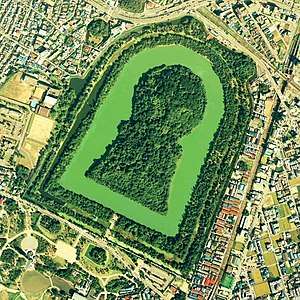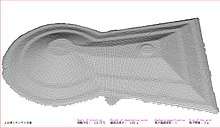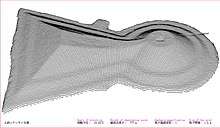Mozu Tombs
The Mozu Tombs (百舌鳥古墳群, Mozu kofungun) are a group of megalithic tombs in Sakai, Osaka Prefecture, Japan. Originally consisting of more than 100 tombs, only less than 50% of the key-hole, round and rectangular tombs remain.[1][2]
| Mozu Tombs 百舌鳥古墳群 | |
|---|---|
| Sakai, Osaka Prefecture, Japan | |
 Daisenryo Kofun, 2.8 km in circumference and the largest kofun in Japan, is thought to be the Tomb of Emperor Nintoku. | |
 Mozu Tombs 百舌鳥古墳群 | |
| Coordinates | 34.564°N 135.487°E |
| Site information | |
| Owner | Imperial Household Agency |
| Condition | Intact |
| Site history | |
| Built | 3rd to 6th century |
| Criteria | Cultural: iii, iv |
| Reference | 1593 |
| Inscription | 2019 (43rd session) |
| Area | 166.6 ha |
| Buffer zone | 890 ha |


The Daisenryo Kofun (大仙陵古墳, Daisenryō kofun)[3], the largest kofun in Japan, are believed to have been constructed over a period of 20 years in the mid 5th century during the Kofun Period. While it cannot be accurately confirmed, it is commonly accepted that the tomb was built for the late Emperor Nintoku.[4] The Imperial Household Agency of Japan treats it as such.
In 2010, the Japanese government proposed that the Daisen Kofun and the entire cluster of Mozu Tombs and Furuichi Tombs be designated as a UNESCO World Heritage Site.[5] 9 years later on 6 July 2019, the site was approved and inscribed as a UNESCO World Heritage Site under Criteria: (iii) and (iv) as the Mozu-Furuichi Kofun Group: Mounded Tombs of Ancient Japan.[6]
Location
The Mozu Kofungun is located in Sakai which is within the Osaka Prefecture, on terraced land overlooking the Osaka Bay. The Furuichi kofungun is located in nearby Habikino and Fujiidera cities.[7]
History
In the Japanese archipelago, there are tumuli (kofuns), which are mounds of earth and stones erected over graves of the ruling class. More than 20,000 were built as monuments between the later part of the 3rd century and the 6th century.[8] It was the peak period of building such mounds.[7] They represent a cultural tradition which is an expression of "forms, and design of the kofun" of the sociopolitical hierarchical order and the link that was prevalent during that period between regions. This period is termed as the Kofun Period.[8] The most prominent imperial mausolea in this cluster of tumulus are those of emperor Nintoku and emperor Richu.[9]
Features
The kofun are found in many shapes and dimensions in varying patterns. Some are of simple circular or square shape (empun and hōfun). The larger ones are keyhole-shaped (zempō kōenfun); they represent the highest class of kofun and were built in great detail.[8] The three prominent aspects of these kofun are their massive size and being surrounded by several moats and many secondary kofun.[7]
In the Osaka Plain and Nara Basin, which were the cultural centre of the Kofun Period, the rounded keyhole-shaped tombs were built extending to very large lengths, out of which the Mozu-Furuichi Kofunguns are the most prominent. These are in two kofun groups which are dated to the later part of 4th and early part of 6th centuries. These kofun are of the largest dimensions in the country. The Nintoku-tennō-ryō Kofun, is one grave mound which is a 486 metres (1,594 ft) long tumulus enclosed by a moat and a fortification which is 840 metres (2,760 ft) in length; this is said to be the largest such mound in the world. This cluster also has the Richū-tennō-ryō Kofun, made of a tumulus of 360 metres (1,180 ft) length and said to be the third largest in the country.[8]
Another group of mounds, located about 10 kilometres (6.2 mi) away from the Mozu cluster is known as the Furuichi cluster. It has the Ōjin-tennō-ryō Kofun of 425 metres (1,394 ft) length which is said to be the second largest in the country. This group also has 11 more huge massive rounded "keyhole-shaped kofun" with mound length of 200 metres (660 ft) or more.[8]
A feature of these funerary mounds is that they contain – along with the buried people – items made of iron, weapons worn by individuals including arrowheads, swords, hoe and spade tips, and many other similar items. Also found in the mounds are antiquities made of gilded bronze such as horse tacks and sash buckles.[7] The Daisen Kofun mound is approximately 500 metres (1,600 ft) long and 300 metres (980 ft) across at its widest point, while the entire tomb area is 840m long.[10] Enclosed by three moats, the mound rises approximately 35m above the surrounding terrain. The inner moat is the widest of the moats at approximately 60 metres (200 ft). The mound is approximately 100,000 square metres (1,100,000 sq ft) in area, and the entire tomb is 460,000 square metres (5,000,000 sq ft).
Today, the tomb is off-limits and protected by the Imperial Household Agency in the centre of Sakai City. The moats have been maintained and provide a sanctuary for fish and waterbirds. The mound itself is completely overgrown by vegetation. A viewing platform from the second (middle) moat is accessible at the south side of the site. The viewing platform is 500m away from Mozu Station on the Hanwa Line and is directly across the street from the Sakai City Museum.[11] This museum provides visitors with information about the kofun and its history.
See also
- Takamatsuzuka Tomb
- List of Special Historic Sites
- List of National Treasures of Japan (archaeological materials)
- Buried Cultural Properties
- World Heritage Sites in Japan
References
- "Enjoying Sakai - Kofun Tombs (Tumuli)". Sakai City. Archived from the original on 22 July 2011. Retrieved 8 May 2011.
- "Kofun Database". Sakai City. Archived from the original on 22 July 2011. Retrieved 8 May 2011.
- https://www3.nhk.or.jp/nhkworld/en/tv/japanologyplus/program-20180619.html
- "堺市・仁徳陵古墳". kiis.or.jp. Retrieved 23 February 2017.
- Centre, UNESCO World Heritage. "Mozu-Furuichi Kofungun, Ancient Tumulus Clusters - UNESCO World Heritage Centre". unesco.org. Retrieved 23 February 2017.
- "Seven cultural sites inscribed on UNESCO's World Heritage List". UNESCO. 6 July 2019.
- "Characteristics of Mozu-Furuichi Kofungun". World Cultural Heritage for Osaka. Retrieved 22 November 2015.
- "Mozu-Furuichi Kofungun, Ancient Tumulus Clusters". UNESCO. Retrieved 22 November 2015.
- Fawcett 1990, p. 111.
- city, Sakai. "仁徳天皇陵古墳(大山古墳) 堺市". sakai.lg.jp. Retrieved 23 February 2017.
- city, Sakai. "堺市博物館 堺市". sakai.lg.jp. Retrieved 23 February 2017.
Bibliography
- Fawcett, Clare P. (1990). A study of the socio-political context of Japanese archaeology. McGill University, Montréal.CS1 maint: ref=harv (link)
External links
- (in English) Entry on UNESCO World Heritage tentative list
- (in Japanese) Mozu Kofun database
- (in Japanese) Decorated Kofun Database